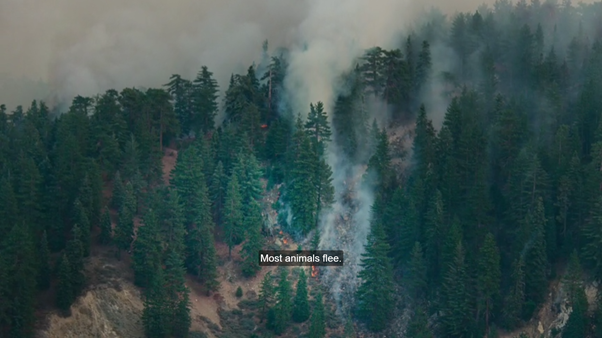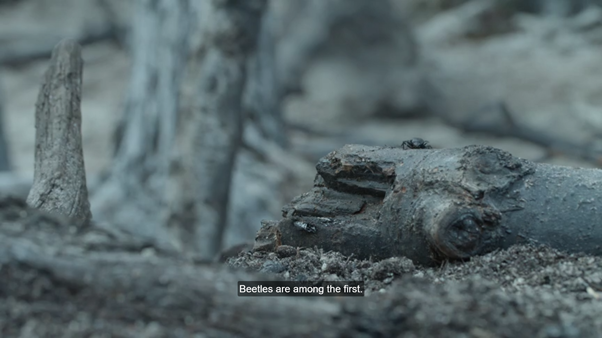
Delighted to see two scenes in amazing #PrehistoricPlanet speculating on fire ecology and how dinosaurs may have interacted with fire.
A thread on context with living species, and hopefully @TetZoo will explain the creators’ thought process in other episode threads. 1/🧵
A thread on context with living species, and hopefully @TetZoo will explain the creators’ thought process in other episode threads. 1/🧵

@TetZoo Episode 4 (Ice Worlds) introduces an unspecified troodontid, which I presume is based on Troodon / Stenonychosaurus / Latenivenatrix (contentious classification) because of the remarks on its relatively large brain and intelligence. 2/ 

@TetZoo Their estimated brain size of around 45 grams is indeed very large for their body of 45 kg, which led Dale Russell to conclude they must have been highly intelligent and might have evolved – if they did not go extinct – into his famous dinosauroid. 3/
https://twitter.com/tetzoo/status/1436297977262452739
@TetZoo I was excited to see this painting by Ely Kish in @TetZoo’s paper on the dinosauroid. It suggests that fire was essential for its ancestors, as it was for ours and continues to be in all contemporary societies. 4/
cdnsciencepub.com/doi/10.1139/cj…
cdnsciencepub.com/doi/10.1139/cj…

@TetZoo Troodondits are noted to hunt animals feeling from the fire. This is not uncommon for various predators so it would not be strange if some dinosaurs did so too, but I don’t know if this species lived in a fire-prone environment, which is associated with this hunting strategy. 5/ 

@TetZoo It then picks up a burning stick and drops it to spread the fire. I’m fairly certain this is based on Australian black kites and other “fire hawks” that have been observed to do so, although unfortunately nobody has captured it on film. 6/
doi.org/10.2993/0278-0…
doi.org/10.2993/0278-0…

@TetZoo Here you can see an example of black kites gathering near a bushfire and swooping for prey. 7/
@TetZoo In general, animal response to fire can be classified as avoidance, association, habituation and interaction (dm for pdf). 9/
link.springer.com/referenceworke…
link.springer.com/referenceworke…
@TetZoo People generally assume that animals always avoid fire (see also episode 5), which may be the case for most species. Still, fire is not such a dominant direct threat, given it has larger impacts through its ecological impact rather than direct mortality. 10/ 

@TetZoo Some animals associate with burnt landscapes. For instance, there are pyrophilous insects that rely on burned wood for reproduction or feeding. Later, sprouting vegetation attracts herbivores, which in turn attract predators (particularly the case for wolves). 11/ 

@TetZoo Habituation refers to animals responding calmly to fire without avoiding it. Vervet monkeys and savanna chimpanzees forage and rest near ongoing fire while monitoring its intensity. 12/
@TetZoo Interaction covers behaviours such as manipulating, exploring, and playing with fire. The most complex natural interaction is that of the fire-spreading kites, but captive primates have also shown appreciation of fire behaviour and how to handle it. 13/
@TetZoo Although complex interaction and exploitation of fire is more likely to occur in species adapted to the frequent presence of fire, those from fire-free environments can learn to do so too. My research on this has just started, but here’s a primer. 14/
aeon.co/essays/how-ani…
aeon.co/essays/how-ani…
@TetZoo It wouldn’t be strange for a large-brained predator such as the troodontid to interact with fire this way, particularly in fire-prone areas. For comparison, their 45 g brains (45 kg body) is larger than that of black kites (6 g for 0.5 kg body) or ostriches (42 g for 100 kg). 15/
@TetZoo There’s many issues with predicting cognitive abilities based on brain size, but there’s not much more we can get from fossils. Still, it’s not unreasonable to estimate such abilities in this manner, especially if maniraptorans had the same neuronal scaling rules as birds. 16/
@TetZoo Episode 5 (Forests) introduces the fact that some plants rely on fire to reproduce. This is called serotiny (pyriscence is actually the more accurate term) and found among others in pine trees. 17/ 

@TetZoo The Atrociraptor is shown to associate with burned areas by feeding on the beetles attracted to dead wood. Again, I don’t know if it lived in a fire-prone environment, but in general the earth has witnessed fires since there were land plants, and certainly the Mesozoic too. 18/ 

@TetZoo Smoke is indeed a great way to get rid of bugs, which humans at least have employed for a long time. However, it doesn’t seem common for animals to do so with wildfires so this is more speculative – certainly when using a burning stick as a fumigation tool. 19/ 

@TetZoo Humans provide more opportunities for animals to “fumigate” themselves, as shown by this rook atop a smoking chimney. 20/
https://twitter.com/scottishbirding/status/1145993165868032000
@TetZoo Many birds “ant” by applying ants and certain substances to their plumage for maintenance. Captive corvids may do so with smoke, flames, matches and cigarettes. This is the cover of Maurice Burton’s peculiar book “Phoenix Re-born”. 21/ 

@TetZoo His rooks would also “sunbathe” in the heat of the fire. 22/ 

@TetZoo More pictures from his book because it’s just so cool and after a decade of working with corvids, they continue to surprise me. 23/ 







@TetZoo Finally, there’s an ankylosaur attracted to the burned landscape to consume charcoal. This is presumably based on the nodosaur Borealopelta fossil with preserved stomach content, of which 6% constituted charcoal. 24/
royalsocietypublishing.org/doi/10.1098/rs…
royalsocietypublishing.org/doi/10.1098/rs…

@TetZoo This function of charcoal is well-known, and some animals (e.g. Zanzibar red colobus monkeys) eat charcoal for this reason. It’s hard to say if this singular case was intentional as charcoal can also be eaten accidentally. 25/
@TetZoo Dinosaurs may also have eaten ash because it is rich in various minerals. This is also seen in various animals, and some people supplement their chickens with extra calcium with this cheap solution. 26/
@TetZoo Sorry for long threat – got carried away. Overall, hat tip to the team behind this amazing documentary! Some fire-related behaviour was more speculative than others, but who knows given the long time that (big-brained) dinosaurs were around, and all-around good showcasing.27/FIN 

• • •
Missing some Tweet in this thread? You can try to
force a refresh






